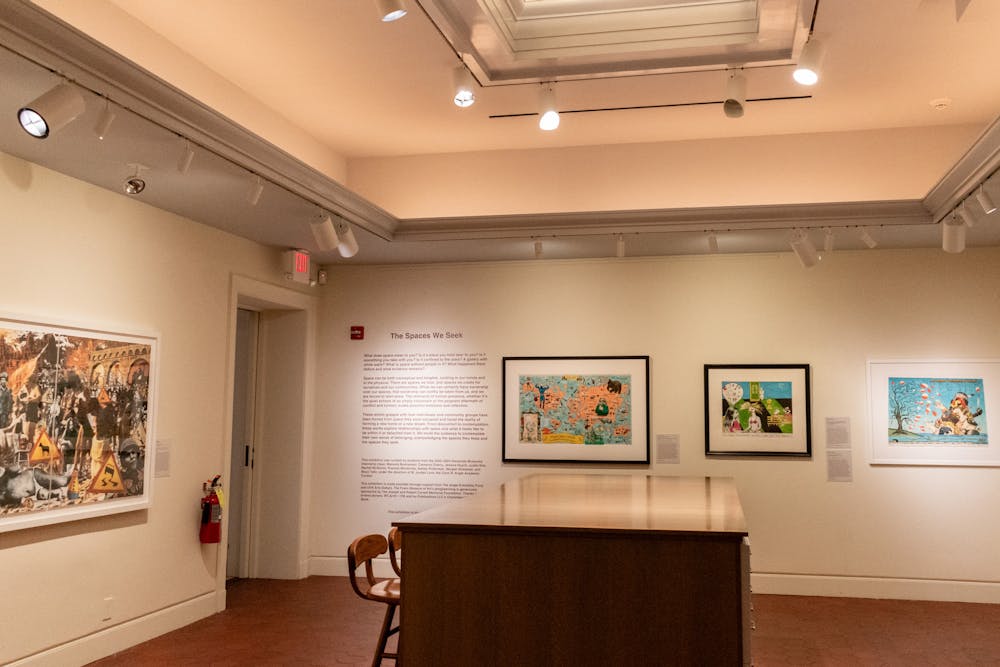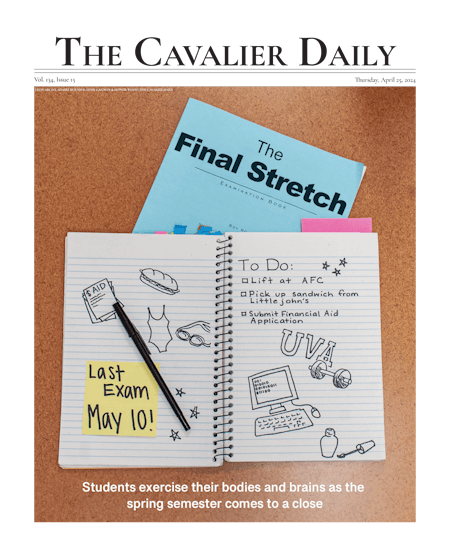The students in the art history department’s University Museums Internships course work with museum professionals to curate an art exhibit, carefully selecting pieces that work to highlight an important theme to the Charlottesville community. This year, the team of students worked together to curate “The Spaces We Seek,” an exhibit centering around the ways in which people take up the physical and metaphorical space around them.
The year-long, six-credit Museums Internships course is a special opportunity where students interested in museum professions can learn more through working at an art museum in Charlottesville. Partnering with either the Fralin Museum of Art or Kluge-Ruhe Aboriginal Art Collection, students collaborate with their classmates, working 100 hours per semester within the museum to curate an exhibit centered around a central theme of their choice.
The students in the Museum Internships class landed on “The Spaces We Seek” as their final theme. Representing a variety of different cultural backgrounds and visual art styles, the intentional selection of each piece in the exhibit explores how identity interacts with the way in which a person occupies — or is displaced from — a space.
According to the students who organized the exhibit, the theme of space is especially poignant when presenting art in the medium of an art gallery. As a space specifically reserved for viewing artwork, the gallery provides a place in which viewers can find a sense of belonging and oneness with art. Morgan Strassner, member of the program and fourth-year College student, spoke to the significance of space in the Fralin.
“There are so many different ways to conceptualize space and how we interact with it,” Strassner said. “We're also using the space, the literal space of the Fralin, to amplify these stories that haven't been [told].”
To create the perfect exhibit is meticulous in nature, and it takes a lot of time, according to Strassner. The students began working with advisor and academic curator M. Jordan Love on crafting “The Spaces We Seek” at the very beginning of the Fall 2023 semester, and their work culminated in the exhibit’s opening on Apr. 3.
“The very first class, Jordan sent us an email to start thinking about what kind of themes [we] want to explore … what [we] want to amplify in the Fralin,” Strassner said. “We all came together and discussed those themes and voted. After that, we looked in the permanent collection on the Fralin’s website, to find pieces that would fit [the theme].”
After choosing their theme, students spend the fall semester selecting the pieces that will go into the exhibit. Each student then chooses one particular piece as their contribution and conducts extensive research on the history of the work and the way it represents the discussion of space-seeking.
According to fourth-year College student Justin Kim, collaboration is at the center of the selection process of both the theme and the individual pieces within the exhibit. Kim said he was grateful for the class’s emphasis on teamwork, which he believes was key to the success of their final product.
“I really appreciated the opportunity to not just bounce ideas off other students and with full time staff, but to have ideas rejected and suggested for improvement,” Kim said. “I think it was really unique to approach something as a group and have all our different perspectives and opinions on where we wanted to end up.”
Strassner’s piece, “The Thingly Thingness of Things” by Mexican artist Enrique Chagoya, focuses on the erasure of indigenous populations in space, an example of a voice often marginalized, especially in visual art. The work — located on the wall opposite the entrance — features an eye grabbing pop art style, which draws immediate attention upon stepping into the room.
“My piece mainly discusses the different ways that colonization has taken space from native individuals,” Strassner said. “When you look at it, all the heads of Native people have been covered up by white Hollywood stars and military people … It's really interesting, his work.”
Modern pop art is not the only style featured in the exhibit. Kim decided to display a photograph entitled “Silencio Militar” from a series by Colombian photographer Juan Manuel Echavarría. The photo contrasts two military hammocks with a classroom chalkboard, which Kim says shows the overwhelming effect of Colombian political conflict on the children of the country.
“[The photos] really captured me because of this idea of space in the absence of presence,” Kim said. “I think that sort of parody is interesting, especially in museums where people might be alone with their thoughts. They’re having a conversation with the artist and with different cultures that typically they wouldn't encounter on a day to day basis.”
The students in the class said they hope the wide variety of pieces on display and the quiet and reflective atmosphere of the art museum encourage museum-goers to examine the spaces they inhabit in their own lives. Kim said that the variety of perspectives included in the exhibit reflects how people with diverse identities can occupy space in different ways.
“These artists don't want their work to be purely negative, or purely showing a cynical interpretation of our world,” Kim said. “The fact is that their creative expression is lasting, and it's meaningful. It doesn't say just one thing about a group, their existence or the space that they've occupied and it can't say one specific thing about what that process looked like for them … We wanted to definitely do away with ideas of minority groups being lost in the turning wheel of progress.”
Upon exiting the room, there is an interactive wall where visitors are invited to create their own space through drawing on and hanging up postcards. Strassner said she hopes that these postcards not only depict space but also take it up themselves and that the exhibit allows audiences to reflect on spaces in their own lives.
“I think I'd want [audiences] to leave thinking about the ways they interact with the world around them,” Strassner said. “Here at the University or out in town or even at home, I guess [we want to encourage] a little bit of introspection — What am I doing while I'm in this space? How am I impacting other people in the space?”
“The Spaces We Seek” will be on display on the second floor of the Fralin until Jul. 14. Those looking to enroll in the University Museums Internships Class next year must apply by May 1.





